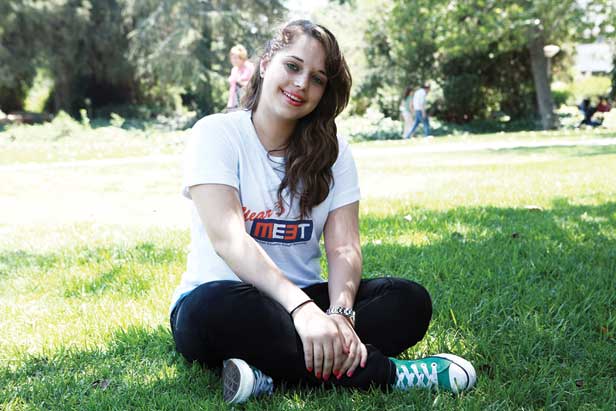Scaling Walls

Every morning on my way to school in Jerusalem, I walked by a seemingly infinite concrete wall bristling with armed watchtowers, electric fences, and cameras. Built by Israel, this barrier along the border of the Palestinian-controlled West Bank has torn into the lands of my childhood. As a child I played in the shadow of the olive trees, but now my brother plays in the shadow of the wall.
The wall has made me determined to look beyond it and seek to overcome its divisiveness. So when I was in ninth grade, I joined Middle East Education through Technology (MEET), an MIT-run computer science and business program that brings Israeli students together with Palestinian students like me. Founded on the belief that Palestinian and Israeli youth need a new way to communicate, MEET gives students a common professional language and allows them to learn about each other’s cultures and the similarities and differences between them.
The three-year program brings more than 100 Palestinians and Israelis together in Jerusalem for a month each summer and once a week for four hours throughout the academic year. In the summer sessions, students learn new material and work on small projects. During the academic year, they work on big projects for competitions—developing an online chat program, their own version of the game Mastermind, or a website, among other cool things.
Instructors from MIT come to Jerusalem to take part in the summer programs. They teach Java, JavaScript, jQuery, SQL, HTML, CSS, and, more recently, Python. In addition to programming, MEET students learn about business concepts and gain leadership skills.
I joined MEET in the summer of 2008. On my first day, I was nervous and worried, for I hadn’t ever met any Israeli students. I didn’t know what to expect or how to talk to them; they were the “others.”
As we worked together, we learned more and more about each other. The way we saw each other slowly changed; we started looking at a fellow student as a good programmer or a good project manager instead of the “other” or the “enemy.”
Our first technology project was during the Gaza War in December 2008 and January 2009. On the news were sad images of the violence in Gaza, and here I was partaking in a program with Israelis and leading a binational team. As a project manager overseeing a seven-member team, I knew that succeeding in this role would mean more than achieving the team’s goals; it would mean breaking the misconceptions the Israelis had about the Palestinians, setting an example of coöperation, and showing some of the guys that girls can be successful leaders.
Over the next few weeks our team developed an online chat system from scratch. I had to set and oversee goals and divide the work among us. I especially had to overcome the deep apprehension the team members felt. To break the tension, I led a discussion emphasizing that we needed to focus on our joint goals, practice professionalism, and find mutual respect. Throughout, I also made sure to lead by example, working closely with both my Palestinian and Israeli teammates. Eventually, we won the top project prize that year, a day at Microsoft!
In the summer of 2010, I graduated from MEET and joined its alumni network, which now has more than 100 members. Events for alumni are organized regularly to keep us involved in the program. I am one of those alumni who keep visiting even when there isn’t an event, because we love MEET so much.
MEET has opened my eyes to a new world of possibilities—a world I didn’t know existed before. It allowed me to meet people I wouldn’t have met otherwise and get to know about their cultures. I’ve learned so much more than computer science and business; I have learned to accept people from different backgrounds, to work with them and love every one of them. MEET gave me the tools to make a difference in my community and beyond, but most important, MEET gave me another family and a new home. I’ve climbed the wall.
Lina Kara’in ’15 studies architecture at MIT. “I want to leave an imprint on my community, and I believe that I do not need to be a politician to make a difference,” she says. “As an architect I will help shape the way my community lives and thrives.” For more on MEET, see web.mit.edu/misti/mit-meet.
Keep Reading
Most Popular
Large language models can do jaw-dropping things. But nobody knows exactly why.
And that's a problem. Figuring it out is one of the biggest scientific puzzles of our time and a crucial step towards controlling more powerful future models.
How scientists traced a mysterious covid case back to six toilets
When wastewater surveillance turns into a hunt for a single infected individual, the ethics get tricky.
The problem with plug-in hybrids? Their drivers.
Plug-in hybrids are often sold as a transition to EVs, but new data from Europe shows we’re still underestimating the emissions they produce.
Stay connected
Get the latest updates from
MIT Technology Review
Discover special offers, top stories, upcoming events, and more.